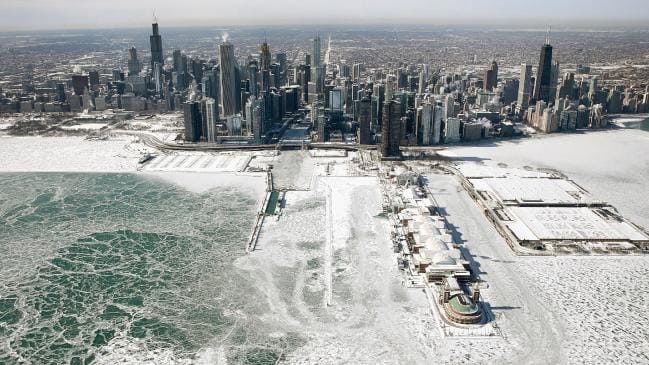
© AFPAn aerial view of Chicago.
A week of extreme cold has left more than two dozen people dead - but even as temperatures rise, the wild weather is not over.
After a week of sub-zero temperatures that left more than two dozen people dead, the United States' midwest is finally about to thaw.
But the extreme weather is not over.
America's National Weather Service has warned residents to brace for massive temperature swings.For example, the twin cities of Minneapolis and St Paul
will go from -32 degrees celsius to seven degrees on Sunday local time, then plunge back down to -23 degrees by Wednesday.
On the local fahrenheit temperature scale, that's "about 125 degrees in temperature change" in a week, the NWS says.
US media outlets
have labelled the erratic weather a "thermal backlash". The phenomenon could cause new problems for residents, as melting ice threatens to flood rivers and icicles fall from skyscrapers.
It comes amid the fallout from a polar vortex that wreaked havoc across multiple states, disrupting public transport, grounding flights and shutting businesses and schools.
The human toll was even more shocking. As temperatures plunged as low as -34 degrees celsius - -45 degrees after the wind chill was factored in - tragic stories emerged of people who had frozen to death outside.
Ada Salna, a 90-year-old from Michigan,
died after locking herself out of her home while feeding her pets.
An 18-year-old university student, Gerald Belz, was found dead behind an academic hall on campus.
Hundreds more people were injured, with hospitals reporting huge surges in cases of frostbite and hypothermia.
Hennepin Healthcare in Minneapolis normally sees around 30 frostbite patients in an entire winter. It admitted 18 in the past week, spokeswoman Christine Hill said Friday.
"I definitely saw more frostbite than I've ever seen in my entire career just in the last three days," said Dr. Andrea Rowland-Fischer, an emergency department physician at Hennepin Healthcare.
Most of those patients, she said, had underlying problems that made it difficult for them to take care of themselves: the developmentally delayed, the mentally ill, the very young and the very old.
They also included people with injuries related to drugs and alcohol - people who passed out or did not realise they were cold or injured.
"It's heartbreaking when there are people who can't take care of themselves and get exposed, just because they either escape from the care that they're being given or because they're not being supervised."
Others got frostbite on their way to work after being exposed to the cold for a short time, often on their hands, feet, ears and face. That included people whose cars would not start or who got stuck outside for other reasons, as well as those who just did not think they could get frostbitten so quickly and went outside without gloves or other protective gear.
Several required "maximal treatment" - admission to the hospital's burn unit for therapies that include drugs to restore circulation to try to avoid amputations.
Some of them will probably still require amputations, a decision usually made by burn doctors four to 10 days after the injury.
Another danger was from carbon monoxide poisoning. A family of nine in Wheeling, Illinois, about 50kms northwest of Chicago, was taken to local hospitals after heating their home with a charcoal grill.
In Rockford, Illinois, four people were treated because they had warmed up cars in a closed garage or because a furnace vent became blocked by ice and snow.
The snow that accompanied the cold also caused problems.
In Raymond, New Hampshire, the driver of a state Department of Transportation vehicle was struck in the head Thursday after ice and snow flew off a truck ahead and broke through the windshield. The driver was hospitalised with a laceration to the head and other possible injuries.
In just a two-day period, Tuesday and Wednesday, Mercyhealth in Rockford treated 15 people for broken bones from falling on the ice, 10 people who were in car crashes caused by snow and eight people who complained of chest pain or shortness of breath from shovelling snow, hospital officials said.
By Friday, the deep freeze had mostly abated, with temperatures climbing as high as the low -5 degrees celsius in Minneapolis and Chicago.
In western North Dakota, the temperature in Dickinson climbed above freezing - a jump of nearly 60 degrees compared with Tuesday's low of -27 degrees.
More than 216 million people in the United States faced temperatures below zero throughout the week.-
with AP
Comment: Woman takes it upon herself to rent hotel rooms and feed the homeless during Chicago's deep freeze